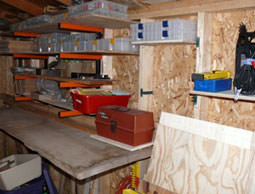
 Photo by Jim Ruen The PortaMate (in orange) supports a 2-inch-thick, 6-foot by 22-inch slab of black walnut, not to mention a myriad “in-transition” tools and supplies. Note the shelf brackets to the right. |
Setting up shelving can be a time-consuming process as you evaluate what you want stored and where. Because I am trying to use available space between studs, mounting shelves can be as simple as cutting 1-inch pieces of lath and fastening them to the top and bottom of a board cut to fit the stud space. I will be doing a fair number of these supports in the coming weeks. They lend themselves well to stud depth shelves but aren’t as well-suited to holding longer and larger materials.
Arguably, better support systems are available in a myriad styles and sizes. While many use angled supports, those can get in the way of stored materials. As I looked at alternatives, the PortaMate five-shelf wood rack and shelf brackets designed for between stud shelves caught my eye.
The PortaMate has two 33½-inch uprights that attach to the wall with 11½-inch arms that mount at 8-inch intervals. Each set of arms can hold up to 55 pounds. Although designed for wood storage, I installed two 52½-inch-long, 15-inch-deep, 3/8-inch-shelves. I notched them to fit between the mounting-stud edges. The spaces between studs are ideal for the plastic units I use for screws, nails and other hardware.
The eight shelf brackets fasten to the stud edges with two screws and to opposing stud faces with a single screw. Predrilled holes make it easy to retain 1/2-inch-thick plywood or other sheeting. Simply mark a line using a level across the opposing stud edges, and fasten with supplied screws.
Both systems were easy to install, will work well for my evolving needs and will lend themselves to easy rearranging as needed.




